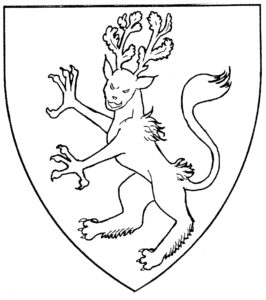“Smoking gun territory”

Calygreyhound
Sometimes spelled Calgreyhound, it is “…a creature spawning from Medieval Heraldry. The Calygreyhound is most commonly shown with the head of a wildcat, body of a deer, forelegs of an eagle and hind legs of an ox. However other body parts substituted were body of an antelope, hind legs of a lion, antlers or horns and a tail of a lion or poodle. Used as the coat of arms for the de Vere family [SOF emphasis]. It is considered somewhat less believable a creature than other heraldic beasts. It is meant to represent swiftness.” [Definition from this site.]
In The Oxfordian Volume 22, 2020, author Michael Hyde details the late Robert Brazil’s research into the printing and publishing history of the Shakespeare quartos in his Edward de Vere and the Shakespeare Printers (2010) and offers intriguing insights into the true authorship of the canon. Brazil found signs of Edward de Vere, 17th Earl of Oxford, throughout the quartos and in the First Folio by focusing on title pages and their printing emblems. One such discovery occurred when he pursued the Green Man emblem and its uses in Thomas Watson’s Hekatompathia (1582) which was “dedicated to Oxford, edited by Oxford, and probably paid for by him” (169). He correctly notes that the Hekatompathia is “the acknowledged source for plot elements in Shakespeare’s Othello and Measure for Measure.” He calls this discovery “smoking gun territory” and we learn why when he compares this title page woodcut of Watson’s work of 1582 with emblems that appear on both the dedication and the catalogue pages of the preface to the Shakespeare First Folio of 1623 (FF).
He states, “Incredibly, this emblem in the First Folio of Shakespeare is modeled on an emblem that first appeared in an Oxford related publication, Hekatompathia, of 1582… the emblem on Hekatompathia is nearly identical to the Folio Woodcut” (211). He continues, “if you compare the two cuts closely, you will see that they are not the same exact design, and the later emblem completes what is missing in the Original.” That is, the 1582 woodcut shows “only the heads of the calgreyhounds” facing inwards in the lower right and left corners, while the Folio pages show the full animals, including their antlers, greyhound bodies, curled tails and claws.


